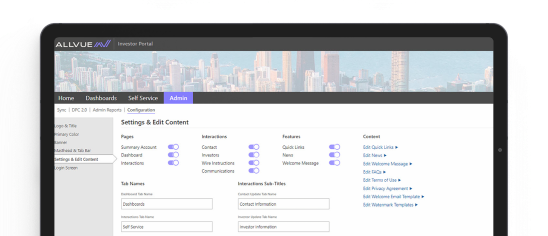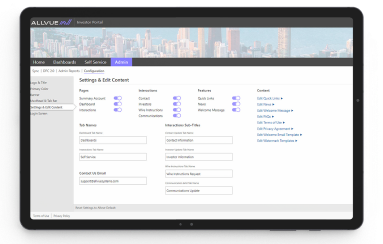What growing private debt managers should know before investing in operational infrastructure
Private debt is experiencing explosive growth, and with that growth comes increased complexity, investor scrutiny, and the need for scalable infrastructure. While many firms can get by with spreadsheets and stitched-together tools early on, that approach quickly becomes a bottleneck as portfolios expand and fund structures become more sophisticated.
If you’re evaluating new technology to support your private debt strategy, you’re not alone.
At Allvue, we’ve worked with many credit managers navigating the shift from early-stage operations to institutional-grade infrastructure. To help demystify the landscape, we created the Private Debt Buyer’s Guide, a resource tailored to firms like yours.
This article previews some of the key themes explored in the full guide and offers a framework to help you begin your evaluation journey. The full buyer’s guide is available at the bottom of the page.
_______________________________________________________________________________________________________________________________________________________
The Growing Pressure on Private Debt Operations
The operational demands of private debt are increasing. Managers must handle more complex loans (like unitranche facilities or delayed draw term loans), coordinate across teams, and meet heightened reporting expectations—often without expanding headcount.
We regularly see firms hitting inflection points like:
- Launching a second fund or onboarding institutional capital
- Managing new investment strategies with higher data and compliance demands
- Struggling to produce timely, reliable reports from disconnected systems
These are clear signs it’s time to invest in technology that can streamline operations and support scale. But finding the right partner can be daunting.
Understanding the Technology Landscape
Private debt managers today have several categories of solutions to consider, each with tradeoffs. In the complete guide, we walk through the pros and cons of:
- Manual workflows: Common in early-stage firms, but prone to error, delays, and inefficiency
- Point solutions: Tools focused on either front office or back office operations, which often require manual reconciliation or complex integrations
- Admin tech overlays: Helpful for visibility, but limited in customization and data ownership
- Enterprise platforms: Broad systems with credible capabilities but less focus on private debt
- Integrated credit platforms: End-to-end systems designed specifically for private debt, offering modular functionality and front-to-back coverage
As you explore these options, looking beyond checklists and focusing on strategic fit is critical.
What to Look for in a Technology Partner
Your operational challenges today may differ from what you’ll face two years from now. That’s why we recommend evaluating potential vendors across five key dimensions (outlined in full in the buyer’s guide):
- Fit for Private Debt
Is the system built to handle the nuances of private debt, not just syndicated loans or public markets? Does it support your asset types, payment structures, and workflow needs across the front and back office? - Workflow Integration
Can the platform connect your deal team, operations, and accounting functions? Does it reduce manual work and support faster decision-making? - Scalability and Flexibility
Can you start small and grow over time without needing to replatform? Will the solution adapt as your fund structures evolve? - Data Ownership and Reporting
Do you control your data? Can your team produce investor notices, internal reports, and audit-ready outputs without relying on vendor support? - Strategic Platform Considerations
What’s the vendor’s long-term focus? Are they committed to serving private debt managers or have competing priorities? What does their roadmap look like?
These categories can help you differentiate between short-term fixes and long-term partners.
Why “Good Enough” Isn’t Good Enough
Many platforms can handle the basics of what you need. But as your strategy grows more complex, these tools often fall short.
For example, we’ve seen managers run into:
- Delays when reconciling interest payments and accruals across systems
- Gaps between deal activity and accounting teams due to disconnected workflows
- Difficulty reporting on structured loans or consolidated fund performance
These aren’t just operational annoyances—they’re obstacles to fundraising, investor trust, and strategic growth. The right platform can help eliminate these risks and lay the foundation for scale.
A Preview of What’s Inside the Full Buyer’s Guide
The Private Debt Essentials Buyer’s Guide was developed specifically for emerging and growth-stage private debt managers who are ready to invest in technology but want to do it thoughtfully.
In the complete guide, you’ll get:
- A breakdown of the vendor landscape with clear categories and what to watch for
- A structured evaluation framework with weighted criteria
- Questions to ask potential vendors during the selection process
- A case study showcasing how one firm scaled operations without adding headcount
- A preview of Allvue’s Private Debt Essentials offering—a modular solution designed to meet your needs today and scale with you tomorrow
Ready to Build Your Operational Foundation?
Choosing a technology partner isn’t just about solving today’s problems. It’s about preparing your firm to move faster, scale smarter, and meet the expectations of investors, partners, and regulators as you grow.
If you’re at that inflection point, this guide will help you make a confident, informed decision.
Download the Full Guide
Get the complete buyer’s guide to evaluate vendors, structure your selection process, and find the right partner for your private debt strategy.



